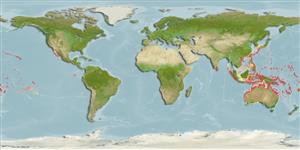>
Eupercaria/misc (Various families in series Eupercaria) >
Scaridae (Parrotfishes) > Scarinae
Etymology: Scarus: Greek, skaros = a fish described by anciente writers as a parrot fish; 1601 (Ref. 45335).
More on author: Bleeker.
Environment: milieu / climate zone / depth range / distribution range
Ökologie
seewasser riff-verbunden; tiefenbereich 3 - 30 m (Ref. 90102). Tropical
Western Pacific: Ryukyu, Sulawesi, Palau (Belau), and Marshall Islands. Also found in Indonesia (Ref. 8631).
Size / Gewicht / Alter
Maturity: Lm ? range ? - ? cm
Max length : 54.0 cm TL Männchen/unbestimmt; (Ref. 90102)
Rückenflossenstacheln (insgesamt) : 9; Rückenflossenweichstrahlen (insgesamt) : 10; Afterflossenstacheln: 3; Afterflossenweichstrahlen: 9. Large primary phase individuals have a distinctive red coloration and lunate caudal fin (Ref. 1602). Females recognized by the red-outlined scales and males by their somewhat elongated snout (Ref. 48636). Median predorsal scales 6;
Uncommon inhabitant of clear lagoon and seaward reefs, usually seen along drop-offs (Ref. 9710). Solitary.
Life cycle and mating behavior
Maturities | Fortpflanzung | Spawnings | Egg(s) | Fecundities | Larven
Oviparous, distinct pairing during breeding (Ref. 205).
Myers, R.F., 1991. Micronesian reef fishes. Second Ed. Coral Graphics, Barrigada, Guam. 298 p. (Ref. 1602)
IUCN Rote Liste Status (Ref. 130435)
Bedrohung für Menschen
Harmless
Nutzung durch Menschen
Tools
Zusatzinformationen
Download XML
Internet Quellen
Estimates based on models
Preferred temperature (Ref.
123201): 24.5 - 29.3, mean 28.5 °C (based on 2606 cells).
Phylogenetic diversity index (Ref.
82804): PD
50 = 0.5000 [Uniqueness, from 0.5 = low to 2.0 = high].
Bayesian length-weight: a=0.01445 (0.00686 - 0.03044), b=3.03 (2.86 - 3.20), in cm total length, based on LWR estimates for this Genus-body shape (Ref.
93245).
Widerstandsfähigkeit (Ref.
120179): mittel, Verdopplung der Population dauert 1,4 - 4,4 Jahre. (Preliminary K or Fecundity.).
Fishing Vulnerability (Ref.
59153): Moderate vulnerability (42 of 100).
Nutrients (Ref.
124155): Calcium = 32.2 [21.1, 54.1] mg/100g; Iron = 0.694 [0.486, 1.048] mg/100g; Protein = 18.6 [16.6, 20.4] %; Omega3 = 0.0846 [, ] g/100g; Selenium = 20.1 [12.7, 32.0] μg/100g; VitaminA = 44.1 [13.3, 144.3] μg/100g; Zinc = 2.04 [1.55, 2.65] mg/100g (wet weight);
